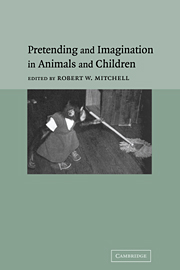Book contents
- Frontmatter
- Contents
- List of contributors
- Foreword by Sue Taylor Parker
- Preface and acknowledgments
- I Historical, developmental, and comparative overviews
- II Pretense and imagination in children
- 4 Language in pretense during the second year: what it can tell us about “pretending” in pretense and the “know-how” about the mind
- 5 A longitudinal and cross-sectional study of the emergence of the symbolic function in children between 15 and 19 months of age: pretend play, object permanence understanding, and self-recognition
- 6 Caregiver-child social pretend play: what transpires?
- 7 Just through the looking glass: children's understanding of pretense
- 8 Young children's understanding of pretense and other fictional mental states
- 9 Pretend play, metarepresentation and theory of mind
- 10 Replica toys, stories, and a functional theory of mind
- 11 Young children's animal-role pretend
- 12 Imaginary companions and elaborate fantasy in childhood: discontinuity with nonhuman animals
- III Pretense and imagination in primates
- IV Prospects
- References
- Author Index
- Subject Index
11 - Young children's animal-role pretend
Published online by Cambridge University Press: 13 August 2009
- Frontmatter
- Contents
- List of contributors
- Foreword by Sue Taylor Parker
- Preface and acknowledgments
- I Historical, developmental, and comparative overviews
- II Pretense and imagination in children
- 4 Language in pretense during the second year: what it can tell us about “pretending” in pretense and the “know-how” about the mind
- 5 A longitudinal and cross-sectional study of the emergence of the symbolic function in children between 15 and 19 months of age: pretend play, object permanence understanding, and self-recognition
- 6 Caregiver-child social pretend play: what transpires?
- 7 Just through the looking glass: children's understanding of pretense
- 8 Young children's understanding of pretense and other fictional mental states
- 9 Pretend play, metarepresentation and theory of mind
- 10 Replica toys, stories, and a functional theory of mind
- 11 Young children's animal-role pretend
- 12 Imaginary companions and elaborate fantasy in childhood: discontinuity with nonhuman animals
- III Pretense and imagination in primates
- IV Prospects
- References
- Author Index
- Subject Index
Summary
Animals are compelling presences in the world of young children, and yet the opportunities they offer for understanding topics in child development have often gone unexplored. The variations different animals present as social interactants can provide insight into a range of topics, such as children's understandings of intentionality, intersubjectivity, and sense of self-and-other. Pretense is another such topic – indeed one which draws on all of those listed above as well.
This chapter will describe the animal-role pretend play and imitation of the children in a year-long ethnographic study of a class of 24 preschoolers, ages 3 years 6 months to 6 years. At these ages, children are already adept at pretend play and we have a good understanding of their capacities for understanding others' minds. In this chapter, the focus is on how these abilities are deployed, and to what consequences, in animalrole pretend play. The chapter asks: how much and when do children pretend to be animals?; what do children do when they pretend to be animals?; and what does animal-role pretense contribute developmentally? The episodes to be described enable some generalizations about children's concepts of animal pretense; about how an animal differs from a human as a role in pretend, and about children's conceptions of animals' similarities and differences from humans. Children's animal roles entailed less use of language than did other roles, including in negotiating the pretend frame itself.
- Type
- Chapter
- Information
- Pretending and Imagination in Animals and Children , pp. 154 - 166Publisher: Cambridge University PressPrint publication year: 2002
- 3
- Cited by



